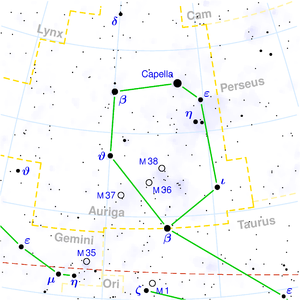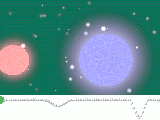Epsilon Aurigae

This is a learning project to study a variable star called epsilon Aurigae. The star is bright enough to be seen without the aide of a telescope. Scientists are requesting the help of amateur astronomers and the public to study an eclipse that occurs every 27 years to better understand the nature of this star system. The last eclipse was from 2009 until 2011. The next eclipse is predicted to occur from 2036 to 2038.[1]
Participants in this project will learn how to identify stars in the night sky and make measurements of the brightness changes of the variable star. You do not need a telescope or any other equipment. The measurements that you make will then be submitted to professional astronomers. An additional lesson will show you how to analyze the data yourself.
Background information
[edit | edit source]
A binary star system consists of two stars that orbit around each other. Often, the two stars are too close together to see through a telescope. We can learn that a star is binary by watching the combined light from the two stars change in brightness. A graph of this change over time is called a light curve. In the diagram at left there is a large and a small star. The orbits are oriented so that periodically one star will pass in front of the other and block the light from the other star. The light curve beneath the animation shows the change in brightness of the combined light from the two stars.
References
[edit | edit source]- Citizen Sky observing project
- epsilon Aurigae (AAVSO)
- epsilon Aurigae (HPO)
See also
[edit | edit source]External links
[edit | edit source]- Calling All Amateur Astronomers: Help Solve a Mystery, August 24, 2009, wired.com
